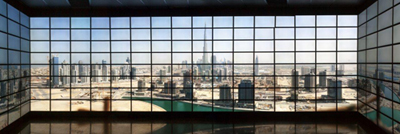The highest-resolution immersive visualization facility ever built
November 21, 2012

Image of Dubai, United Arab Emirates viewed in the Reality Deck (credit: SBU)
Stony Brook University (SBU) recently unveiled its new Reality Deck, with 1.5 billion pixels total on 416 super-high-resolution screens in a four-walled surround-view theater — the highest-resolution immersive display ever built — and driven by a 220 TFLOPs graphic supercomputer.
Its purpose and primary design principle is to enable scientists, engineers, and physicians to tackle current problems that require the visualization of vast amounts of data.
The Reality Deck is the first to break the one-gigapixel (one-billion-pixels) mark, with a resolution five times higher than the second largest in the world.
“This technology will be used for visualizing and analyzing big data, such as advanced medical imaging, protein visualization, nanotechnology, astronomical exploration, micro-tomography, architectural design, reconnaissance, satellite imaging, security, defense, detecting suspicious persons in a crowd, news and blog analyses, and climate and weather modeling. It will also be used for storm-surge mapping to fight flood disasters, such as superstorm Sandy and global warming,” said Project Director, Arie E. Kaufman, PhD, Distinguished Professor and Chair of the Computer Science Department and Chief Scientist at the University’s Center of Excellence in Wireless and Information Technology (CEWIT).
In the Reality Deck, data is displayed with an unprecedented amount of resolution that provides 20/20 vision, and renders traditional panning or zooming motions obsolete, as users just have to walk up to a display in order to resolve the minutiae, while walking back to appreciate the context that completely surrounds them.
Dr. Kaufman added, “We’ve never had a way to analyze and display tremendous amounts of data at one time before. This is revolutionary for visual analytics, which is the most powerful and critically important analyses.”
Another feature of the Reality Deck is the “infinite canvas,” a 360-degree smart screen that changes images according to the location of the viewer walking around the Reality Deck, so the same image is never viewed twice and infinitely big data can be explored. It also has a high-performance sound system with 22 speakers and four subwoofers. Future applications to stream video in real time are also in the works.
Images displayed at the demonstration included water level mapping for storm surge due to extreme weather events, satellite imagery of New York City and parts of Long Island that demonstrated a next-generation Google map, the 2008 Presidential inauguration, Milky Way visualization from NASA and the European Southern Observatory, and protein visualizations of the E. coli bacteria.
”The Reality Deck will spur medical breakthroughs, groundbreaking new technologies and greater partnerships with industry that will help to create new jobs,” said Yacov Shamash, Dean of the College of Engineering and Applied Sciences and Vice President of Economic Development at Stony Brook University. “
The Reality Deck was constructed with a $1.4 million National Science Foundation (NSF) grant and a $600,000 match from Stony Brook University.